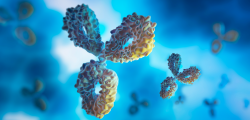The
clustered regularly interspaced short palindromic repeats, known as CRISPR systems are adaptive immune mechanisms commonly
present in archaea and bacteria. The CRISPR systems enable the host to specifically
target and cleave foreign nucleic acids thus targeting infectiousviruses and
plasmids. Recently, a type V CRISPR system has been identified in several
bacteria, the Cpf1 CRISPR from Prevotella and Francisella 1. In contrast to
Cas9 systems, CRISPR/Cpf1 systems are smaller in size, do not require an
additional trans-activating crRNA (tracrRNA), and allow for targeting of
additional genomic regions by cleaveing the target DNA proceeded by a short
T-rich protospacer-adjacent motif (PAM). On the other hand, the Cas9 system requires
a G-rich PAM following the target DNA. Furthermore, Cas12a/Cpf1 introduces a
staggered DNA double stranded break with a 4 or 5-nt 5’ overhang. Recombinant
Acidaminococcus sp. BV3L6 Cas12a (cpf1) nuclease is expressed in E. coli and
purified. The nuclease contains nuclear localization sequence (NLS) at the
C-terminus and 6× His-tag at the C-terminus.
|



































